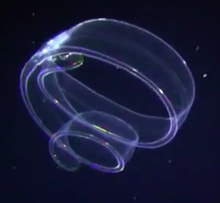| Venus girdle | |
|---|---|

| |
| Photographed in Hawaii | |
|
Scientific classification
| |
| Domain: | Eukaryota |
| Kingdom: | Animalia |
| Phylum: | Ctenophora |
| Class: | Tentaculata |
| Order: | Cestida |
| Family: | Cestidae |
| Genus: |
Cestum Lesueur, 1813 |
| Species: | C. veneris
|
| Binomial name | |
| Cestum veneris Lesueur, 1813
| |
The Venus girdle (Cestum veneris) is a comb jelly in the family Cestidae. It is the only member of its genus, Cestum, [1] and is also the largest of all known ctenophores.
Description
Venus girdles resemble transparent ribbons with iridescent edges. They may grow up to a metre in total length. Canals run the length of the ribbon in which bioluminesce activates when disturbed. [2]
Distribution
This species is pelagic and is found in tropical and subtropical oceans worldwide in midwater. [2]
Ecology
These animals swim horizontally using muscular contractions as well as the beating of the comb rows. The oral edge leads. They eat small crustaceans. [2]
References
- ^ "WoRMS - World Register of Marine Species - Cestum veneris Lesueur, 1813". marinespecies.org. Retrieved 10 September 2013.
- ^ a b c Wrobel D. & Mills C. 2003. Has no bell, no tentacles,found in the Mediterranean Sea. Pacific Coast Pelagic Invertebrates: a guide to the common gelatinous animals. Sea Challengers. ISBN 0-930118-23-5
| Venus girdle | |
|---|---|

| |
| Photographed in Hawaii | |
|
Scientific classification
| |
| Domain: | Eukaryota |
| Kingdom: | Animalia |
| Phylum: | Ctenophora |
| Class: | Tentaculata |
| Order: | Cestida |
| Family: | Cestidae |
| Genus: |
Cestum Lesueur, 1813 |
| Species: | C. veneris
|
| Binomial name | |
| Cestum veneris Lesueur, 1813
| |
The Venus girdle (Cestum veneris) is a comb jelly in the family Cestidae. It is the only member of its genus, Cestum, [1] and is also the largest of all known ctenophores.
Description
Venus girdles resemble transparent ribbons with iridescent edges. They may grow up to a metre in total length. Canals run the length of the ribbon in which bioluminesce activates when disturbed. [2]
Distribution
This species is pelagic and is found in tropical and subtropical oceans worldwide in midwater. [2]
Ecology
These animals swim horizontally using muscular contractions as well as the beating of the comb rows. The oral edge leads. They eat small crustaceans. [2]
References
- ^ "WoRMS - World Register of Marine Species - Cestum veneris Lesueur, 1813". marinespecies.org. Retrieved 10 September 2013.
- ^ a b c Wrobel D. & Mills C. 2003. Has no bell, no tentacles,found in the Mediterranean Sea. Pacific Coast Pelagic Invertebrates: a guide to the common gelatinous animals. Sea Challengers. ISBN 0-930118-23-5